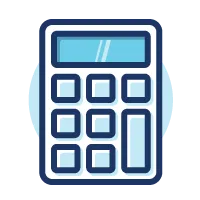Key Takeaways
- Many businesses fail because they lack cash reserves.
- Choose the best family member for the job, not the best job for the family member.
- The Profit First method turns traditional business finances upside down.
- Profit First creates a simplified approach to business finances.
Have you heard that more than half of new businesses will fail in the first five years?
The Bureau of Labor statistics proves this to be almost true. According to their data, approximately 20% of new businesses fail within the first two years, 45% fail within five years and 65% fail within the first 10 years.
Of course, there are numerous reasons why a business could fail. But one of the main reasons for failure is the business’s finances.
Sometimes a business can grow too fast, have too much debt, or have too many expenses. Other times, business owners simply don’t understand how to properly manage their money.
Enter, the Profit First method for business accounting.
The Profit First method is a proven business accounting strategy for businesses to curb their financial struggles. Here we’ll talk about the benefits of Profit First and how to implement it in your business.
Using the Profit First Method for Business Accounting
The Profit First method divides your business’s revenue into five bank accounts, while prioritizing its profit.
In essence, the Profit First method turns the normal way of business accounting upside down.
| Traditional Business Accounting: | ||||
| Revenue | - | Expenses | = | Profit |
| Profit First Method: | ||||
| Revenue | - | Profit | = | Expenses |
The Profit First method has been so disruptive in the world of business financing because it focuses on creating a profit margin from Day One. This is much different from traditional accounting where the business focuses on revenue and expenses, leaving profit as something to be optimized down the road.
Putting off profit until a later date, though, means that the business likely won't make it long enough to create an actual profit.
Why Use the Profit First Method?
Have you ever looked back at your income from 10-20 years ago and compared it to what you make now? Chances are you’re probably earning a lot more today than you did back then. However, you still might be facing the same financial struggles that you were having when you were earning a much lower income.
This is why we see celebrities go broke and multi-millionaires still living paycheck to paycheck.
Parkinson's Law states that work will expand to fill the time allotted for its completion. Meaning, if you have a week to get something done, you will use the week. But if you have a month to get the same thing done, you will use the entire month.
This same principle applies to business accounting: the more revenue you generate the more your expenses will expand to support revenue growth.
However, this results in little-to-no profit leftover when using traditional business accounting methods.
But when expenses become what is left over after profit is generated, expenses become finite.
How to Use the Profit First Method for Business Accounting
Now that you understand why the Profit First method works so well, let’s dive in and show you exactly how to implement it in your small business accounting.
Before getting started, you need to open five separate checking accounts. Together, each one of these accounts will make up the Profit First system.
Let’s bank on success.
OneAZ delivers the business lending tools you need to help your business thrive.
The 5 Accounts for Profit First
Here’s how each account will work for you in the Profit First method.
1 The Income Account
This account is where all your revenue from sales, services, or other revenue generated will go. Basically, any revenue that is generated in your business goes directly into your income account.
An added benefit is you now have one account for all revenue, simplifying things at the end of the year when you’re reconciling your profit and loss statements.
2 The Profit Account
Next comes your profit account. Profit comes before expenses when using the Profit First method.
For most small business owners, profit has never been viewed as a priority or a targeted amount. Instead, profit is seen as a luxury whenever there’s money left over after all expenses are paid. With Profit First, you determine a set percentage to set aside for profit from the start.
If you don’t know where to start, start with 5% and work from there. You may find in a few months that 5% wasn’t nearly enough and you can raise it, or you may find your business isn’t quite ready for 5% and you can pull it back.
Choose a percentage amount for your profit before you do anything else.
3 The Owner’s Compensation Account
The owner's comp account is where you will receive your take-home pay from the business. You must always pay yourself before you pay any expenses, or you may end up discovering you’re working for free when the expenses slowly creep up over time.
When expenses expand, the business takes up all your time and then doesn’t pay you what you’re worth. This causes businesses to close their doors for good.
4 The Tax Account
You can’t forget about Uncle Sam.
The tax account helps remove stress during tax season because your business will have plenty of money set aside for tax purposes.
The tax account is not the most glorious, but you will be glad you have one when April rolls around.
5 The Operating Expenses Account
Operating expenses round out your fifth and last account.
Moving forward, your business will operate on whatever expenses are left over after you set aside profit, pay yourself, and have enough for taxes.
This also means all your expenses come from one account. Rent, payroll, credit card expenses, inventory, or any other expenses come from the operating expenses account.
Customize the names of each of your accounts in your online dashboard. You might consider labeling with the account name and allocation percentage so you always know how much is going where.
How Much Goes into Each Account?
Remember, the income account is the holding pot for all revenue that comes into your business.
For example, an online store more than likely has much smaller overhead than a brick-and-mortar business, thus changing the amount that goes into operating expenses.
The size of your business and the amount of revenue it generates also determines how much of an owner’s draw you take from the business.
Here are a couple examples of small business accounting with the Profit First method:
Example #1: Small Business using Profit First Method
| Income Account: | $100,000 |
| Profit Account: | 5% or $5,000 per year |
| Owner Comp Account: | 50% or $50,000 per year |
| Tax Account: | 15% or $15,000 per year |
| Operating Expenses Account: | 30% or $30,000 per year |
Example #2: Small Business using Profit First Method
| Income Account: | $250,000 |
| Profit Account: | 3% or $7,500 per year |
| Owner Comp Account: | 40% or $100,000 per year |
| Tax Account: | 15% or $37,500 per year |
| Operating Expenses Account: | 42% or $105,000 per year |
When and How Do I Move Money Between Accounts?
A good rule of thumb is to sweep money from your income account into the other four accounts twice per month. There isn’t a right or wrong day to set this up, but it is best practice to create two days each month to move money.
Determine the best days for collecting your paycheck from the owner comp account. For example, if you plan on getting paid on the 1st and 15th of the month, then it may work well to move money from your income account to all other accounts on the 10th and 25th of the month.
Remember, 100% of whatever is inside your income account will be moved into the other four accounts, thus bringing your balance in your income account to zero. As revenue is generated throughout the month, the income account grows and then is brought back down to zero on the next bi-monthly sweep.
Target Allocations
If you want to take things one step further, consider using target allocations with the Profit First method.
When you're first starting out, you may discover things are a little tighter than you’d like to simply start off with 10% profit. In this case, create a target allocation amount, or a goal, to eventually get to.
For example, you may start off with a profit amount of only 1% but your goal is to eventually set aside 10% for profit. This will result in changes to your owner comp and operating expenses accounts to leave more room for your profit account.
By creating target allocations, you create a roadmap for building a strong financial foundation in your business.
Profit First Method Frequently Asked Questions
- Do I really take my income account down to zero?
- Yes. But in certain circumstances you might need to leave something inside your income account. One example is if you operate an online store and the revenue that goes into your income account can also be withdrawn to be used for returns or refunds to your customers. In this situation, you would need to always keep something in your income account to avoid unnecessary overdraft fees.
- Will my bank or credit union charge me for multiple checking accounts?
- No, most financial institutions do not charge you to have multiple checking accounts. If you are with a financial institution that charges extra fees for additional checking accounts, you may need to utilize business account services or choose a different bank or credit union.
- Why does only 15% go into the tax account?
- You may be feeling nervous about only using 15% for taxes and not having enough to cover the business’s tax liability come tax season. However, 15 percent often leaves you with more than you need for tax filing. The percentage is based on your gross income instead of your net earnings. As a small business owner, you will have operating expenses, owner’s compensation, and other adjustments that will correlate to your net earnings which the business will be taxed on.
- Where did the Profit First method come from?
- Mike Michalowicz is the creator and author of the book Profit First. Michalowicz created the Profit First method after noticing a common stress among most business owners: lack of cash reserves. Since implementing the Profit First method, over 175,000 businesses have taken the Profit First approach to managing their small business accounting
Many businesses fail due to lack of cash reserves or poor financial management. By using the Profit First method for small business accounting, you simplify your business finances while also creating cash reserves.
Any business can implement the Profit First method because of its simplicity. And with over 175,000 businesses already using Profit First, it’s a time-tested and proven strategy for success.
APR = Annual Percentage Rate














